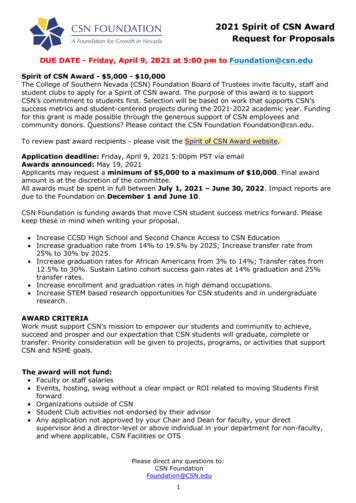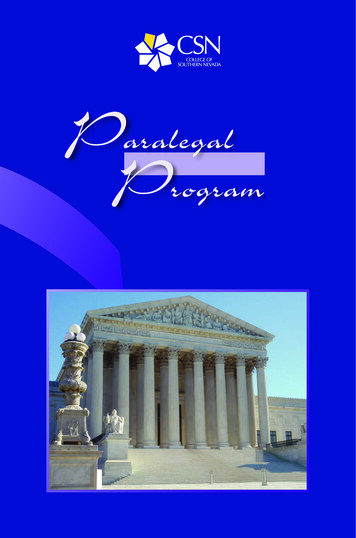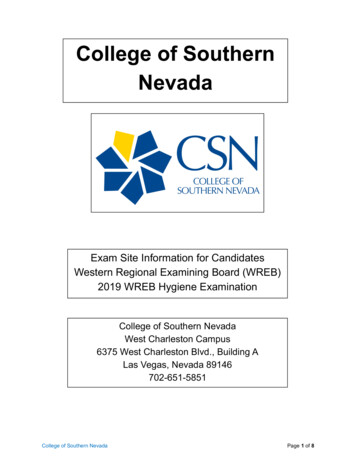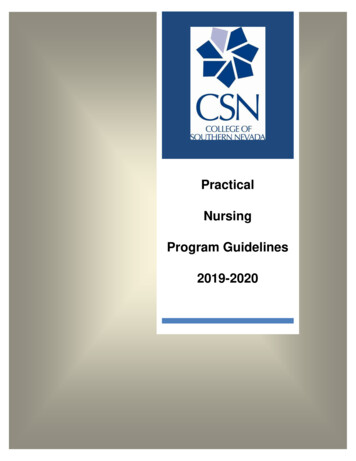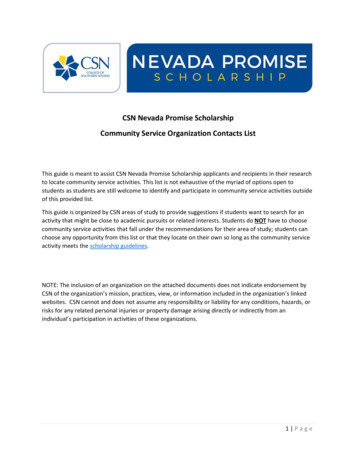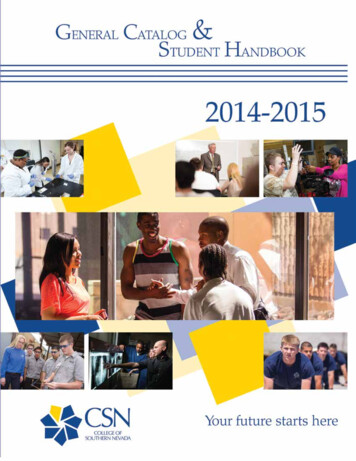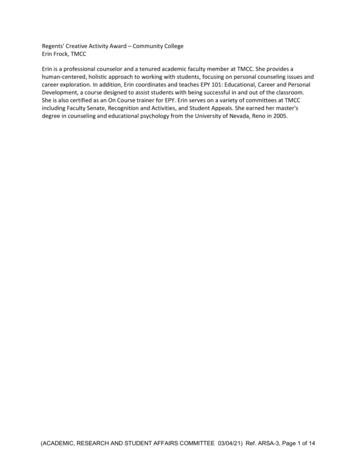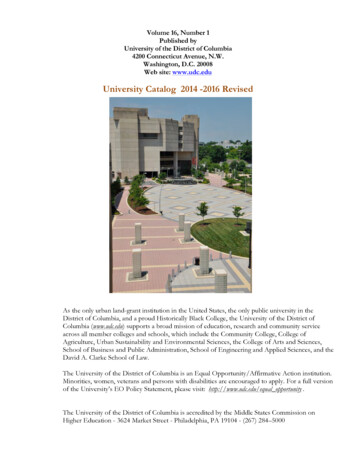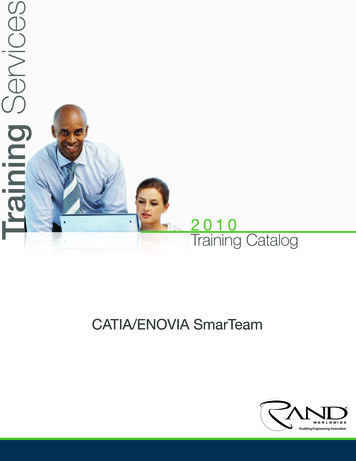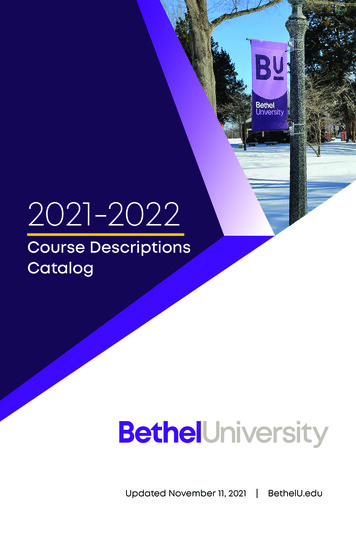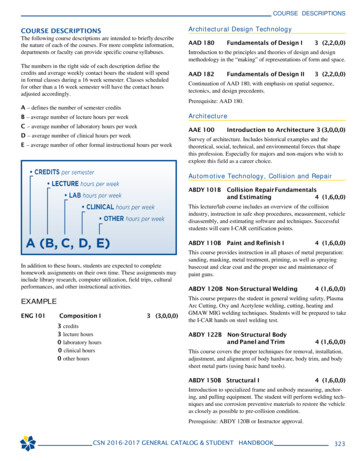
Transcription
COURSE DESCRIPTIONSArchitectural Design TechnologyCOURSE DESCRIPTIONSThe following course descriptions are intended to briefly describethe nature of each of the courses. For more complete information,departments or faculty can provide specific course syllabuses.The numbers in the right side of each description define thecredits and average weekly contact hours the student will spendin formal classes during a 16 week semester. Classes scheduledfor other than a 16 week semester will have the contact hoursadjusted accordingly.AAD 180Fundamentals of Design I3 (2,2,0,0)Introduction to the principles and theories of design and designmethodology in the “making” of representations of form and space.AAD 182Fundamentals of Design II3 (2,2,0,0)Continuation of AAD 180, with emphasis on spatial sequence,tectonics, and design precedents.Prerequisite: AAD 180.A – defines the number of semester creditsArchitectureB – average number of lecture hours per weekC – average number of laboratory hours per weekAAE 100D – average number of clinical hours per weekE – average number of other formal instructional hours per weekIntroduction to Architecture 3 (3,0,0,0)Survey of architecture. Includes historical examples and thetheoretical, social, technical, and environmental forces that shapethis profession. Especially for majors and non-majors who wish toexplore this field as a career choice.Automotive Technology, Collision and RepairABDY 101BCollision Repair Fundamentalsand Estimating4 (1,6,0,0)This lecture/lab course includes an overview of the collisionindustry, instruction in safe shop procedures, measurement, vehicledisassembly, and estimating software and techniques. Successfulstudents will earn I-CAR certification points.ABDY 110B Paint and Refinish IIn addition to these hours, students are expected to completehomework assignments on their own time. These assignments mayinclude library research, computer utilization, field trips, culturalperformances, and other instructional activities.EXAMPLEENG 101Composition I3 credits3 lecture hours0 laboratory hours0 clinical hours0 other hours3 (3,0,0,0)4 (1,6,0,0)This course provides instruction in all phases of metal preparation:sanding, masking, metal treatment, priming, as well as sprayingbasecoat and clear coat and the proper use and maintenance ofpaint guns.ABDY 120B Non-Structural Welding4 (1,6,0,0)This course prepares the student in general welding safety, PlasmaArc Cutting, Oxy and Acetylene welding, cutting, heating andGMAW MIG welding techniques. Students will be prepared to takethe I-CAR hands on steel welding test.ABDY 122B Non-Structural Bodyand Panel and Trim4 (1,6,0,0)This course covers the proper techniques for removal, installation,adjustment, and alignment of body hardware, body trim, and bodysheet metal parts (using basic hand tools).ABDY 150B Structural I4 (1,6,0,0)Introduction to specialized frame and unibody measuring, anchoring, and pulling equipment. The student will perform welding techniques and use corrosion preventive materials to restore the vehicleas closely as possible to pre-collision condition.Prerequisite: ABDY 120B or Instructor approval.CSN 2016-2017 GENERAL CATALOG & STUDENT HANDBOOK323
COURSE DESCRIPTIONSABDY 152B Structural II4 (1,6,0,0)This course prepares the student in the repair of moderate toheavily damaged vehicles using specialized frame and unibodymeasuring, anchoring, and pulling equipment. Continued instruction in welding techniques and corrosion preventive materials torestore the vehicle as closely as possible to pre-collision conditionis included.AC 106B4 (1,6,0,0)This course covers the identity of auto body parts and theirstructural relationships. Removal, installation, adjustment, andalignment of body hardware, body trim, and body sheet metal parts(using basic hand tools) are skills that are mastered in this course.5 (4,2,0,0)Prerequisites: AC 102B and AC 103B.AC 110BPrerequisite: ABDY 150B or Instructor approval.ABDY 180B Non-StructuralAdvanced Body PanelResidential Gas HeatingTypes of gas furnaces, troubleshooting, function of controls, repairof mechanical controls, combustion efficiency tests, piping techniques, proper ventilation and combustion will be covered.Intermediate HVACElectrical Theoryand Application5 (4,2,0,0)This course covers intermediate level electrical diagram drawingand interpretation, enthalpy and psychrometrics, and specializedsystem components for resistance heat HVAC. Labs cover: wiringof various control circuits, and system measurements.Prerequisites: AC 102B and AC 103B and MATH 104B or above(except MATH 122 and MATH 123).Prerequisite: ABDY 122B or Instructor approval.ABDY 220B Paint and Refinish II4 (1,6,0,0)This course covers metal preparation, sanding, masking, metaltreatment, and priming. Spraying of basecoat and clear coat, colormatching, blending, and the proper care of a paint gun are alsoincluded. Students will learn blending, color adjusting and tinting.Prerequisite: ABDY 110B or Instructor approval.Technician CertificationReviewIntroduction toHVAC and Refrigeration0.5 (0.5,0,0,0)3 (2,3,0,0)This is an introduction course covering the mechanical and electrical functions of a HVAC system and the basic refrigeration cycle.This course will prepare students for the EPA 608 certification.AC 102BIntroduction toHVAC Electrical Theoryand ApplicationIntroduction toHVAC MechanicalTheory and Application5 (4,2,0,0)The course will teach heat gain and loss using the J-Manual andworksheets. Students will be taught to do calculations on microcomputers. Also included in this course are the factors affectingsystem design and design procedures using Manual-D.Prerequisite: MATH 104B or MATH 116 or above (except MATH122, 123).AC 115BTroubleshooting5 (4,2,0,0)This course will teach recommended service and diagnosis procedures for air conditioning systems. This will include generaltroubleshooting procedures for both refrigeration and electricalsystems.Prerequisites: AC 106B and AC 111B.AC 116B5 (4,2,0,0)Copper Fundamentals1 (1,0,0,0)Silver braising, Oxy-Acetylene equipment, use of copper tubing,swagging, flaring, bending, and proper cutting techniques in airconditioning applications will be covered.AC 119BThis course covers mechanical and electrical safety, basic mechanical math and physics, the refrigeration cycle, system components,enthalpy, and psychrometrics. Labs cover: recovery, evacuation,leak testing, charging, and system measurements.324Heat Load Calculations5 (4,2,0,0)This course covers electrical safety, basic electrical math, elementary circuit diagram reading and drawing, and motor theory. Labscover: assembly and wiring techniques, and the use of electricalmeters.AC 103B5 (4,2,0,0)This course covers heat pumps and their operation. It will teachvarious defrost methods including time temperature, demand, airswitch and other defrost controls. Charging methods which includesuperheat, weigh-in and dial-a-charge. The course will also includecompressor change out methods and advance wiring. C.O.P.,E.E.R., SEER rating and design points of heat pumps.AC 114BA lecture course to prepare students for certification exam, devotedto all aspects of EPA regulatory requirements under Section 608 ofthe Clean Air Act.AC 101BHeat PumpsPrerequisite: AC 110B.Air Conditioning TechnologyAC 100BAC 111BProfessionals inCustomer Service1.5 (1.5,0,0,0)This course introduces a methodical approach to problem resolution to service professionals (dispatchers, technicians, owners). It isalso designed to contain, qualify, and correct various problems withgood and bad outcomes. This course instructs students to focus ontheir communication skills prior to using technical expertise.CSN 2016-2017 GENERAL CATALOG & STUDENT HANDBOOK
COURSE DESCRIPTIONSAC 120BAir ConditioningDuct Work FabricationAC 220B3 (2,2,0,0)This course covers basic duct work fabrication, as it applies to theAir Conditioning industry. Areas covered include cutting, computing size requirements, plenums and straight fittings.AC 200BCommercial Refrigeration I5 (4,2,0,0)An introduction to commercial refrigeration. Deals with systemcomponents, mechanical and electrical controls, random andplanned defrost, various accessories, application and types of refrigeration systems and troubleshooting basic commercial systems.Prerequisites: AC 110B and either ENG 107 or COM 115.AC 201BHVAC Automatic Controls3 (2,2,0,0)This course presents basic control theory of HVAC mechanical systems to maximize their operating efficiency in commercialand industrial applications. Topics include Direct Digital Controls(DDC), electric, pneumatic and electronic components, controlapplications including microprocessors, and energy management.Commercial Refrigeration II5 (4,2,0,0)This course covers sequence of operation, application, troubleshooting, repair, cleaning, and preventive maintenance techniquesof various types of ice making equipment including flaked, cubed,and crushed ice machines.Prerequisite: AC 200BAC 210BPrerequisite: AC 110BAC 221B5 (4,2,0,0)This course covers operations, safety, water treatment, control devices used with hot water boilers, low pressure boilers, and powerboiler systems.Prerequisite: AC 106BAC 211Transport Refrigeration2 (1,2,0,0)Gas Heat Pump Technology I 5 (4,2,0,0)The student will learn the basics of gas heat pumps. Included willbe an introduction to the various products, controls, and equipment.Basic operational theory and application will be explored as wellas an introduction to installations. R-410a, electrical and mechanical safety will also be covered, designed to give the student a goodoverview of this technology.Prerequisite: AC 111B.AC 295BInternshipHVAC Career1-16 (0,0,0,15-90)This course is designed to provide practical experience applyingthe HVAC (Heating, Ventilation and Air Conditioning) theory andtechniques gained in other CSN HVAC courses through on-the-jobexperience while working alongside experienced HVAC technicians.AccountingACC 105Boiler Operationand Maintenance5 (4,2,0,0)This course prepares students for all necessary operations and prevention maintenance procedures for employment in central plantoperations for high and low pressure chillers. Subjects to include:operation, safety, controls, pumps, maintenance, purge units andcooling towers.Prerequisites: AC 110B.AC 202BChiller Operationsand MaintenanceTaxation for Individuals3 (3,0,0,0)Development of the individual taxpayer’s taxable income throughan analysis of income, exemptions, deductions and credits.ACC 135BBookkeeping I3 (3,0,0,0)Introduction to the basic principles of bookkeeping and accounting,theory of debit and credit, the bookkeeping cycle, journals, ledgers,bank reconciliations and payroll.ACC 201Financial Accounting3 (3,0,0,0)This course covers maintenance, diagnosis, and repair of trailermounted refrigeration systems. Proper refrigerant handling, EPAregulations and certifications are covered and students will be prepared for any required certification processes.Basic accounting techniques with emphasis on the accountingcycle, analysis of financial statements, payables and receivables,plant assets, inventories and internal controls for cash.Prerequisite: DT 165 or Instructor approval.ACC 202AC 212Equipment Cooling5 (4,2,0,0)An advanced course that prepares students to analyze differentrequirements and needs for maintaining exact temperature and humidification requirements of critical systems and process coolingsystems used in data processing plants; hospitals; surgical centers;manufacturing facilities; and power distribution equipment. Topicsinclude: system identification, controls used for process coolingequipment, humidification, ultraviolet cleaning, and filtration of airand water.Prerequisite: AC 110B.Managerial Accounting3 (3,0,0,0)Accounting methods and techniques utilized by corporations, costsystems, budgeting, and the utilization of accounting data for planning and control.Prerequisite: ACC 201.ACC 203Intermediate Accounting I3 (3,0,0,0)Accounting for assets and liabilities, concepts and techniques concerning preparation and analysis of the balance sheet, essentials ofinterest, annuities and present value.Prerequisite: ACC 202.CSN 2016-2017 GENERAL CATALOG & STUDENT HANDBOOK325
COURSE DESCRIPTIONSACC 204Intermediate Accounting II3 (3,0,0,0)Accounting for stockholders’ equity, statement of cash flows, statement analysis, pensions and leases.Prerequisite: ACC 203.ACC 205Cost Accounting3 (3,0,0,0)Cost concepts and decision making, break even techniques, budgets and management analysis.Architectural Design TechnologyADT 100BIntroduction toDrafting Theory3 (2,2,0,0)An introduction to manual drafting theory as utilized in fields ofarchitecture, interior design and graphic arts. Geometric construction, orthographic projection, elevations and isometric drawings areincluded. Open lab will be required.Prerequisite: ACC 201.ADT 103BACC 210BIntroduction to the forces shaping urban development, to include:history and determinants of influence, nature of urban form, comprehensive planning and implementation, zoning, general termsrelating to development, State statutes, and local land use controls.IRS Computerized TaxPreparation Program3 (3,0,0,0)Hands-on experience preparing computerized individual incometax returns utilizing the I.R.S. Electronic Filing System.MicrocomputerAccounting SystemsADT 107B3 (3,0,0,0)Develop skills in the use of computerized accounting. Interactwith on-line realistic computerized accounting systems. Primaryobjective will be to focus on an applications approach using actualbusiness case studies.Prerequisite: ACC 201.ACC 222BAccountingUsing Spreadsheets3 (3,0,0,0)Application of spreadsheet functions using the most popularspreadsheet program, Excel. Techniques covered will be creatingand printing a worksheet, working with files, setting up data bases,and enhancing accounting information with the use of graphs andmacros.Prerequisite: ACC 201.ACC 223BIntroduction to QuickBooks3 (3,0,0,0)Computerized Accounting with QuickBooks is designed to introduce students to the QuickBooks accounting program. The studentwill receive hands-on training in the use of QuickBooks usingfictitious case studies.Prerequisite: ACC 201.ACC 295BWork Experience I3 (0,0,0,15)Cooperative Education course designed to provide the studentwith on-the-job supervised educationally directed work experience with the accounting program. Student must work a minimum average of 15 hours per week for a total of 225 hours toearn practicum work experience credit. Grade will be given uponverification of employment.3263 (3,0,0,0)Prerequisite: ENG 100 or ENG 101 or ENG 107 or ENG 113.Prerequisite: ACC 105.ACC 220Urban PlanningArchitecturalResidential Codes2 (2,0,0,0)The main emphasis of this course will be placed on the ResidentialBuilding Code. Students will also study portions of the ResidentialElectrical, Mechanical, Plumbing and Energy Conservation Codes.ADT 114BHistory ofthe Built Environment3 (3,0,0,0)This course will discuss the history of architecture and citydesign in the western and the non-western civilization. The timeperiods to be covered will be from classical Greek, Hellenistic and Roman, through the Romanesque period, including theevents and architecture of non-western civilization happeningin the same time frame. The influences these architecture anddesign philosophies have had on the shaping of civilization willalso be discussed.ADT 201BIntroduction to BuildingInformation Modeling3 (2,2,0,0)This course introduces students to building information modelingby providing them with the essential tools and concepts for usingAutodesk Revit. Students will develop a project from conceptualdesign to construction documents in a hands-on, scenario-basedlearning environment.ADT 202BIntermediate BuildingInformation Modeling3 (2,2,0,0)This course covers a wide range of intermediate level topics inAutodesk Revit, continuing to build on the concepts introduced inthe Introduction to Revit course.Prerequisite: ADT 201B.CSN 2016-2017 GENERAL CATALOG & STUDENT HANDBOOK
COURSE DESCRIPTIONSADT 205BArchitectural EnvironmentalControl Systems3 (3,0,0,0)This course will help students comprehend the principles of designrelating to the creation of habitats that efficiently meet the needs ofthe intended occupant. Content will include general systems terminology and principles and green building construction.AES 120The Foundations of theUnited States Air Force II1 (1,0,0,0)Survey course designed to introduce AFROTC cadets to the leadership aspects of being an Air Force officer and the environment inwhich the Air Force functions. Course emphasizes the Air Force’score values and other unique characteristics of serving in the United States Air Force.Prerequisites: ADT 107B and GEOG 103.Prerequisite: AES 110 or equivalent.ADT 210BResidentialStructural Technology3 (2,2,0,0)AES 121AFROTC Leadership Lab I-B 2 (0,4,0,0)This course will help students to apply basic structural principlesto problems encountered in the design and construction of residential and light commercial structures not exceeding two stories inheight.A progression of experiences designed to develop leadershipability and awareness of the Air Force lifestyle with emphasis on:Air Force customs and courtesies; drill and ceremonies, physicalfitness, the Air Force officer’s environment and culture and opportunities available to commissioned officers. Graded Pass/Fail.Prerequisite: EGG 131 or PHYS 151.Corequisite: AES 120 or equivalent.ADT 280BArchitecturalResidential DesignAES 2303 (2,2,0,0)Emphasis will be placed on the conceptual process of designing aresidential project. Students will present their final project to a juryof professionals.Prerequisites: ADT 100B and ADT 107B and CONS 120B andAAD 182.ADT 282BArchitecturalResidential Design IIThe Evolution of USAFAir and Space Power I1 (1,0,0,0)Survey course designed to trace the development of the U.S. AirForce air and space power through a historical prism. Begins withthe study of early flight and concludes with the Korean conflict.Special emphasis is placed on the evolving nature of Air Forcecapabilities, functions and doctrineAES 231AFROTC Leadership Lab II-A 2 (0,4,0,0)A continuation of ADT 280B. Students will develop comprehensive design solutions to challenging residential design briefs.An in-depth progression of experiences developing leadership ability and awareness of the Air Force lifestyle. Focus is on continuedmilitary training related to uniform wear, military customs andcourtesies, and military ceremonies. Graded Pass/Fail.Prerequisite: ADT 280B.Corequisite: AES 230 or equivalent.Air Force ROTCAES 240AES 110The Foundations of theUnited States Air Force I3 (2,2,0,0)1 (1,0,0,0)The Evolution of USAFAir and Space Power IISurvey course to trace the development of U.S. Air Force air andspace power through a historical prism. The course begins withthe study of the Vietnam War and concludes with the second waragainst Iraq. Emphasis is placed on the evolving nature of AirForce capabilities, functions and doctrine.A survey course designed to introduce AFROTC cadets andprospective Air Force officers to the Air Force culture. Coursedescribes the heritage and structure of the United States Air Forceand the opportunities available to the Air Force corps.Prerequisite: AES 230 or equivalent.AES 111AES 241AFROTC Leadership Lab I-A 2 (0,4,0,0)1 (1,0,0,0)AFROTC Leadership Lab II-B 2 (0,4,0,0)A progression of experiences designed to develop leadershipability and awareness of the Air Force lifestyle with emphasis on:Air Force customs and courtesies; drill and ceremonies, physicalfitness, the Air Force officer’s environment and culture and opportunities available to commissioned officers. Graded Pass/Fail.An in-depth progression of experiences developing leadership ability and awareness of the Air Force lifestyle. Focus is on continuedmilitary training related to uniform wear, military customs andcourtesies, and military ceremonies. AES 241 is required for allcadets applying to attend Field Training. Graded Pass/Fail.Corequisite: AES 110 or equivalent.Corequisite: AES 240 or equivalent.CSN 2016-2017 GENERAL CATALOG & STUDENT HANDBOOK327
COURSE DESCRIPTIONSApplied Industrial TechnologyAIT 205BIndustry Customer ServiceAM 1521 (1,0,0,0)This course introduces a methodical approach to problem resolution to industry professionals and is designed to contain, qualify,and correct various problems. Students will learn to focus on theircommunication skills prior to using technical expertise. GradedPass/Fail.Academic and Life SuccessALS 101College Success3 (3,0,0,0)Learn strategies for mastering academic and life success. Coursetopics include change, goal setting, money, time/priority management; test preparation, note-taking, memory techniques; relationships, communication, listening, wellness, diversity and personalresponsibility.American Sign LanguageAM 145American Sign Language IAmerican Sign Language II4 (4,0,0,0)Prerequisite: AM 145 or instructor approval.American Sign Language III4 (4,0,0,0)This course promotes the shifting from comprehension to production of ASL, to bring one’s current ASL fluency to a point ofself-generated ASL.Prerequisite: AM 146 or instructor approval.AM 148This course is designed to improve receptive and expressive fingerspelling skills to intermediate/advanced levels.Prerequisite: AM 151 or instructor approval.AM 156A Survey of Deafness1 (1,0,0,0)This survey course provides students an overview of deafnessincluding such topics as: career options, deaf culture, language,communication modes, adaptive equipment and causes of deafness.AM 205Introduction to Interpreting 4 (4,0,0,0)An introduction and overview of the profession of sign languageinterpretation, including standards of practice, Code of Ethics forInterpreters, professionalism, business practices and assessmentskills.4 (4,0,0,0)The course continues to stress the development of basic conversational skills with emphasis on expanding vocabulary and expressive skills.AM 1471 (1,0,0,0)Prerequisites: AM 145-149; and AM 151 and AM 152 or Instructorapproval.Designed mainly to introduce ASL and to focus on the developmentof basic conversational skills, emphasizing receptive skills.AM 146Fingerspelling IIAmerican Sign Language IV 4 (4,0,0,0)AM 206Consecutive Interpreting4 (2,4,0,0)This skills development course focuses on the task of interpretationand transliteration skills between American Sign Language, English, and other communication modes used by deaf people usingconsecutive interpreting strategies.Prerequisites: AM 145-149; and AM 151 and AM 152 or Instructorapproval.AM 207Simultaneous Interpreting4 (2,4,0,0)This skills development course focuses on the task of interpretationand transliteration between American Sign Language, English andother communication modes used by deaf people using simultaneous interpreting strategies.Prerequisite: AM 206.This course encourages the student to expand his or her commandof discourse in ASL on various everyday topics.AM 208Prerequisite: AM 147 or instructor approval.This course provides students opportunities to shadow, observe andinteract with professional interpreters in a supervised observation/practicum setting. Class discussions will be held in seminar format.AM 149American Sign Language V4 (4,0,0,0)A course intended to encourage majors in Deaf Studies to furtherdevelop their conversational ASL abilities, particularly in the areaof self expression.3 (1,0,0,8)Prerequisite: AM 207.AM 209Prerequisite: AM 148 or instructor approval.Observation/Practicumin InterpretingAdvanced Interpreting4 (2,4,0,0)This course is designed to develop basic skills in receptive andexpressive fingerspelling.This course continues the development of skills in interpretationand transliteration in order to prepare students for employment.Emphasis is placed on practical application of theory and processof interpreting in class and lab situations.Prerequisite: Instructor approval or Corequisite: AM 147.Prerequisite: AM 207.AM 151328Fingerspelling I1 (1,0,0,0)CSN 2016-2017 GENERAL CATALOG & STUDENT HANDBOOK
COURSE DESCRIPTIONSAM 210Specialized Interpreting3 (3,0,0,0)ANTH 104Great Discoveriesin Archaeology3 (3,0,0,0)This course introduces students to various areas of interpreterspecialization. Each area of specialization will include generalinformation, specialized vocabulary, interpreting techniques, andtext to analyze and interpret.Examination of famous archaeological discoveries and contemporary archaeological research. Highlights archaeology’s contributions to modern views of the past.Prerequisite: AM 207 with a grade of C or better; or Instructorapproval.ANTH 105AM 211Internship in Interpreting3 (1,0,0,8)This course provides internship experiences to students in the finalsemester of the interpreter preparation program. Site visits will bemade by the instructor.AM 253Deaf Culture3 (3,0,0,0)3 (3,0,0,0)Development of human society and technology from the earliesttraces of culturally patterned behavior to the emergence of civilization in the Old and New Worlds.ANTH 106Prerequisite: AM 210.Introduction toWorld ArchaeologyIntroduction toAnthropological Linguistics 3 (3,0,0,0)This course is designed to introduce students to the American DeafCulture and definitions of culturally linked terms and philosophies.Introduction to the anthropological study of language in the contextof culture. This course also examines the scientific study of phonology, morphology, syntax, and semantics.Prerequisite: Instructor approval or Corequisite: AM 147.ANTH 112AM 254An examination of the application of anthropological conceptsto contemporary society. The results of studies of non-western,sociocultural systems used in considering alternate solutions to theproblems confronting Western man today will be covered.Deaf History3 (3,0,0,0)This course is designed to introduce students to the history of deafpeople and the sociological, psychological, educational, and political forces which have shaped the field of deafness.Social Anthropology3 (3,0,0,0)Prerequisite: Instructor approval or Corequisite: AM 148.ANTH 133AM 255Introduction to theory, analysis and practice in understandingculture and its impact on communication. Emphasis on the use ofcultural awareness and multicultural sensitivity to improve oral andwritten communication. (Same as COM 133.)Structure ofAmerican Sign Language3 (3,0,0,0)This course acquaints students with the information and researchconcerning phonetics, morphology, syntax, semantics, neurolinguistics, psycholinguistics, and sociolinguistics of American SignLanguage. This class will be conducted in American Sign Language without voice.Prerequisite: Instructor approval or Corequisite: AM 148.AM 257ASL/English Translation3 (3,0,0,0)ANTH 201Culture and Communication 3 (3,0,0,0)Peoples andCultures of the World3 (3,0,0,0)A study of human cultural diversity and institutions among variouspeople and societies around the world.ANTH 202Introduction to Archaeology 3 (3,0,0,0)This course is an introduction to the process of working betweentwo languages. Students will analyze textual material and translatefrom the source into the target language with the goal of maintaining semantic accuracy.An examination of the research goals, theoretical foundations, andmethods of anthropological archaeology. Examples are drawn fromarchaeological sites worldwide, with a Great Basin emphasis.Prerequisite: AM 255 or Instructor approval.ANTH 203AnthropologyANTH 101Introduction toCultural AnthropologyIntroduction toPhysical Anthropology3 (3,0,0,0)Intensive survey of major areas of Anthropology. Topics will vary.May be repeated up to six (6) credits.3 (3,0,0,0)An in-depth analysis of culture revealed by world ethnography.ANTH 102Special Topicsin Anthropology3 (3,0,0,0)Genetics, heredity, diversity, and the origins and evolution of humans. Examines basic evolutionary biology, including natural selection, and the relevant history, science, and methods in this field.Prerequisite: ANTH 101.ANTH 204Art in Cross-CulturalPerspective3 (3,0,0,0)An examination of cultural influences on art production, process,and meaning, as viewed across diverse modern, historic, and prehistoric contexts. Philosophies of art and the relationships betweenart and various aspects of culture are explored.CSN 2016-2017 GENERAL CATALOG & STUDENT HANDBOOK329
COURSE DESCRIPTIONSANTH 205Ethnic Groups inContemporary SocietiesANTH 2173 (3,0,0,0)Drums, Culture, andNew World Rhythmatism3 (3,0,0,0)A survey of racial and ethnic intergroup relations in the UnitedStates and other societies. Emphasis is on cultural, social, and institutional factors that lead to group conflict and/or cultural pluralism.Explore relationships between culture and the arts while learningto play hand drums from around the world. Experiential learningfor body and mind.Prerequisite: ANTH 101 or SOC 101. (Same as SOC 205.)ANTH 225ANTH 206African Culture Through OralHistory and Storytelling3 (3,0,0,0)An exploration of the different life-ways in various societies ofAfrica and African Diaspora through oral traditions and folklore.ANTH 207Sport and Culture3 (3,0,0,0)This course looks at the relationship of sport and culture in pastand contemporary world cultures. The course uses western andnon-western sports to illustrate the nature of this relationship.ANTH 209Gender in Cross-CulturalPerspective3 (3,0,0,0)An examination of human gender and sexuality through an investigation of cross-cultural similarities and differences.ANTH 211Introduction to theArchaeology ofNorth America3 (3,0,0,0)Examines the prehistory of North America from the peopling ofthe continent to European contact. Particular emphasis is on theprehistory of the Great Basin.ANTH 212Introduction toNorth American Indians3 (3,0,0,0)Survey of traditional life and modern conditions of American Indians with emphasis on the western United States.ANTH 214Introduction toMesoamericanPrehistor
HVAC and Refrigeration 3 (2,3,0,0) This is an introduction course covering the mechanical and electri- . and the utilization of accounting data for plan- ning and control. Prerequisite: ACC 201. ACC 203 Intermediate Accounting I 3 (3,0,0,0) Accounting for assets and liabilities, concepts and techniques con-
